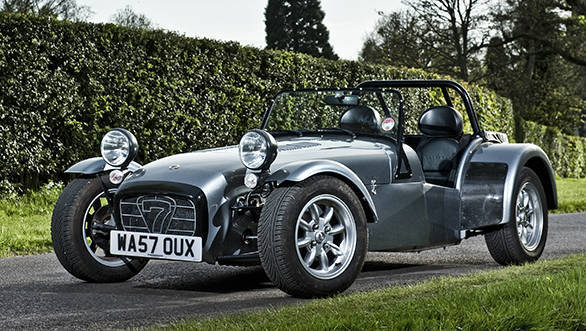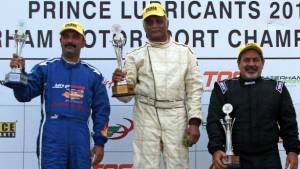Caterham 7 Roadster first drive

Colin Chapman was this clever British structural engineer who built Lotus Cars, an automobile empire which manufactured some of the greatest drivers' cars known to man. These cars were not expensive, neither were they exotic, yes they did look fantastic and they were brilliant to drive. All of these cars stemmed from a simple automotive philosophy that drove him to build such cars and to quote him, "Adding power makes you fast on the straights, reducing weight makes you faster everywhere else". He was one of the foremost designers and builders on the planet who realised that less weight in a car meant better dynamics overall, and it allowed him to lead a team to motorsport greatness. Lotus Cars is one of the most successful names in motorsport history having won the F1 constructors' title a total of seven times with six drivers' titles added to the bag as well. Lotus also went across the pond to the US and won the Indianapolis 500 only because at the time the Indy500 paid out richer rewards than F1.
Using the money from those race wins, Colin built the Lotus 7 in 1958. It was an engineering marvel thanks to its simplicity of design and unparalleled performance. To look at the Lotus 7 isn't going to stir your soul or warm your cockles, but its dynamic abilities were so impressive the car is still manufactured by British automotive firm Caterham Cars. A lot has changed in the car but the basic design especially of that chassis and body work is still the same. What has changed are the powertrain configurations with newer engines finding their way into this car. Nearly 60 years after the Lotus 7 was first built, it still kicks Porsche, Lambo and Ferrari tail all over a circuit. It is one of the purest sports cars of all time and thanks to two enthusiastic brothers, Mohit and Gaurav Burman, scions of healthcare giants the Dabur family, the Caterham 7 is being launched in India.
Despite its diminutive presence the Caterham 7 isn't a car to be trifled with. For that matter any car that weighs just 550 kilos, makes anywhere between 107PS to 265PS across a wide range, all delivered straight to the rear wheels, has no steering assist, no ABS, no airbags and no roof over your head has to be approached with a prayer. I drove a Caterham Roadsport 150 with 150PS weighing just 550 kilos giving it an unholy 270PS per tonne power to weight ratio. My prayer therefore was very, very long!
The Caterham 7 is a very short car, so short you might accidentally trip over it. Driving it on the road, and you will be able to do so because this is going to be a road legal car, will be even trickier. The highest point in the car is just 114 centimetres above the ground, to put that in perspective India's shortest car the Alto at 146cm towers over the Caterham. Step into the bucket seat, let your arm rest on the door and you'd probably scrape your elbow on the road. This car fits like a glove, surgical gloves in fact that you fight to get out off. And if you get into the seat and strap on the four point harness you better not forget to have taken the keys out of your pocket or adjusted the mirrors beforehand because either simply can't be done without unfastening all the straps and then having to relocate all the straps and refastening. And you also ought to quietly mutter another prayer for it to be perfect weather, not too hot or too cold or wet because there is no roof and there is no air conditioning. There is however a heat circulation system which redirects heat from the engine into the cabin. Standing in a parking lot at the Silverstone circuit in the cold was only bearable with the thought that I'd get a few more minutes to spend warming my hands under that hot draft when it came to my turn to drive.
But thumb the red starter button and what you get is all car with the performance equivalent of a supercar. The sharp roar of the exhaust just under your ears (that's where the exhausts actually are) and the vibe of an engine that is quite literally sitting between your knees makes you forget all else. Engage first off the 5-speed manual transmission and its 7th heaven. The Roadster 150 is quick, laying mile long darkies as a 100kmph comes up in under five seconds. That's about as quick as a 2011 Porsche 911 Carrera 4S Cabrio, a C63 AMG, Maserati Quattroporte or a Aston Martin Rapide. Bear in mind that all of those cars cost above a crore of rupees while the Roadster 150 will cost about a third of that. And the performance envelope does not shut there, the Roadster 150 is one of the mildest forms of the Caterham 7. If you look at the more powerful options such as the Superlight R500 variant with the 263 horsepower configuration, it's capable of splitting the 100kmph marker in just 2.88 seconds. The engines are all naturally aspirated units sourced from Ford. In the R150 for instance the 4-cylinder 1.6-litre Sigma engine is used while the more powerful Superlight R series Caterhams use the Duratec Motorsport engines.
There isn't much by way of refinement to be found in any of these mills, it's the trade off for the crush your ribs with g-force sort of raw acceleration. These aren't cars for a lazy Sunday drive visiting your grandmother. The Caterham is a focused track machine that is relentless in its pursuit of driving excellence. The engine responses are sharpened to a very very fine point and the throttle pedal has just two positions, off and full on.
Getting the car sideways as I learnt the hard way isn't the challenge, the car is more than happy to swing the rear around at a moment's notice, it's trying to keep it pointed in the right direction that needs a lot of effort. And that effort is massive because winding the steering to counter the swing takes some getting used to. It draws a lot of strength from your arms and by the first loop of a short drift course I was groaning from the effort of correcting the wheel. Fortunately a few more loops later I got the hang of it and then the steering feels incredibly direct and progressive.
The Caterham 7 Roadster chassis is built using advanced CAD modelling with finite element analysis and computer controlled tube and laser cutters and robot welding processes. It's a stiffer chassis than the hand built chassis that was used before. The rear axle is a de Dion design as compared to the live axle on the previous generation Caterhams. It offers better handling and comfort and along with the adjustable front double wishbone provides heart pounding dynamics. Control the throttle and the Caterham is infinitely balanced with incredible poise though you always get this sense that you're on a knife's edge. And it does all of this with ridiculously small and narrow tyres (185/60) that look like they came from a hatchback. But what the hell, who's interested in trying to keep it straight when crooked lines are just so much more fun.
The Caterham 7 will be available in all variants in India and the Classic and the Roadster will be positioned at the cheaper end of the scale. But what I am looking at more keenly is Caterham's driver and motorsport programs which has prompted them to look at starting assembly operations close to the Delhi circuit. It's the only way the Caterham 7 will become affordable to the Indian enthusiast which by the way is currently pegged at an entry price point just above 25 lakh rupees. I'm thinking of getting involved, it's probably the only way I can get the best of both in our little corner of the automotive world, the Buddh circuit and lots more of the Caterham 7.
Starts Rs 1.67 Crore
2987cc
Automatic
275
600
6.8 Kmpl
Starts Rs 1.38 Crore
2998cc
Automatic
350
530
-NA-










